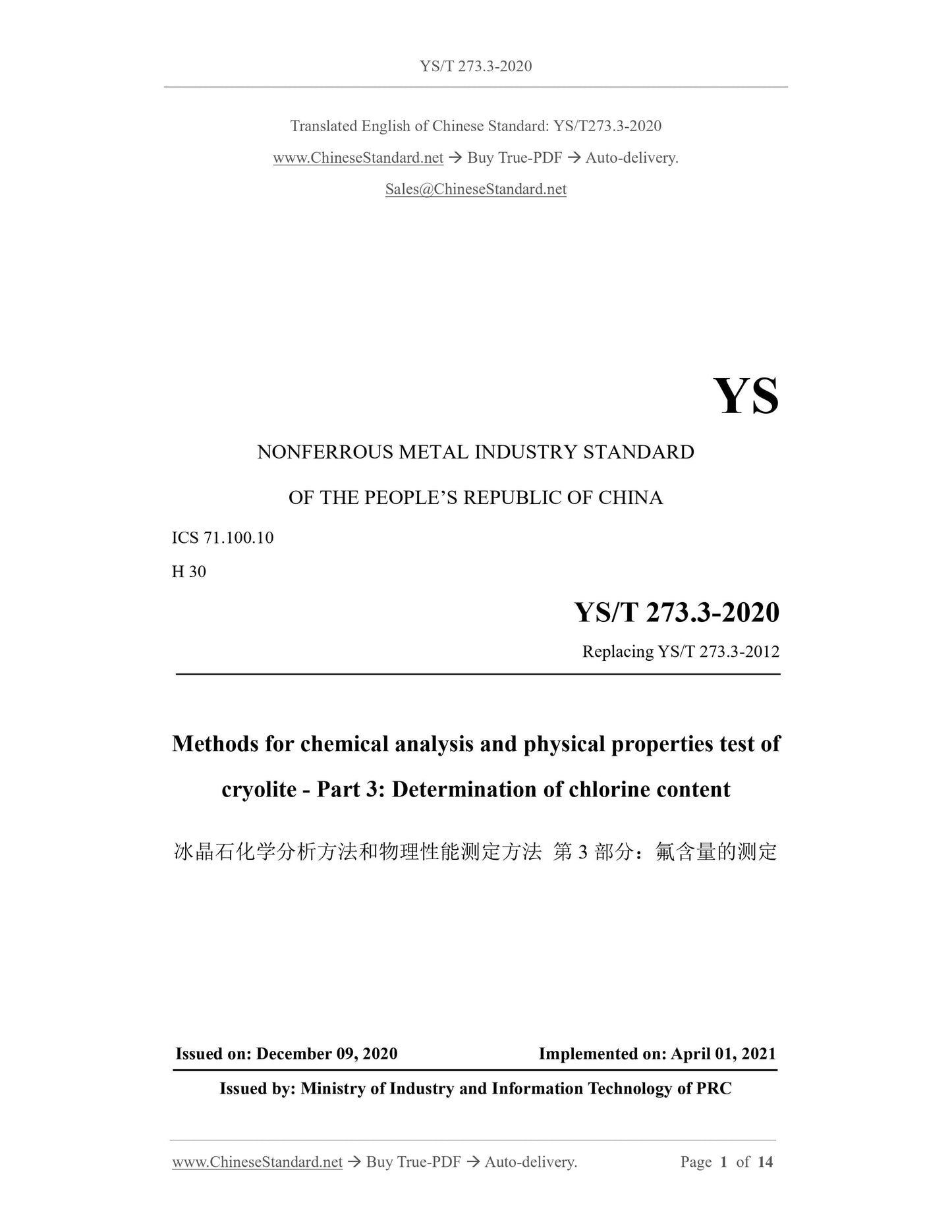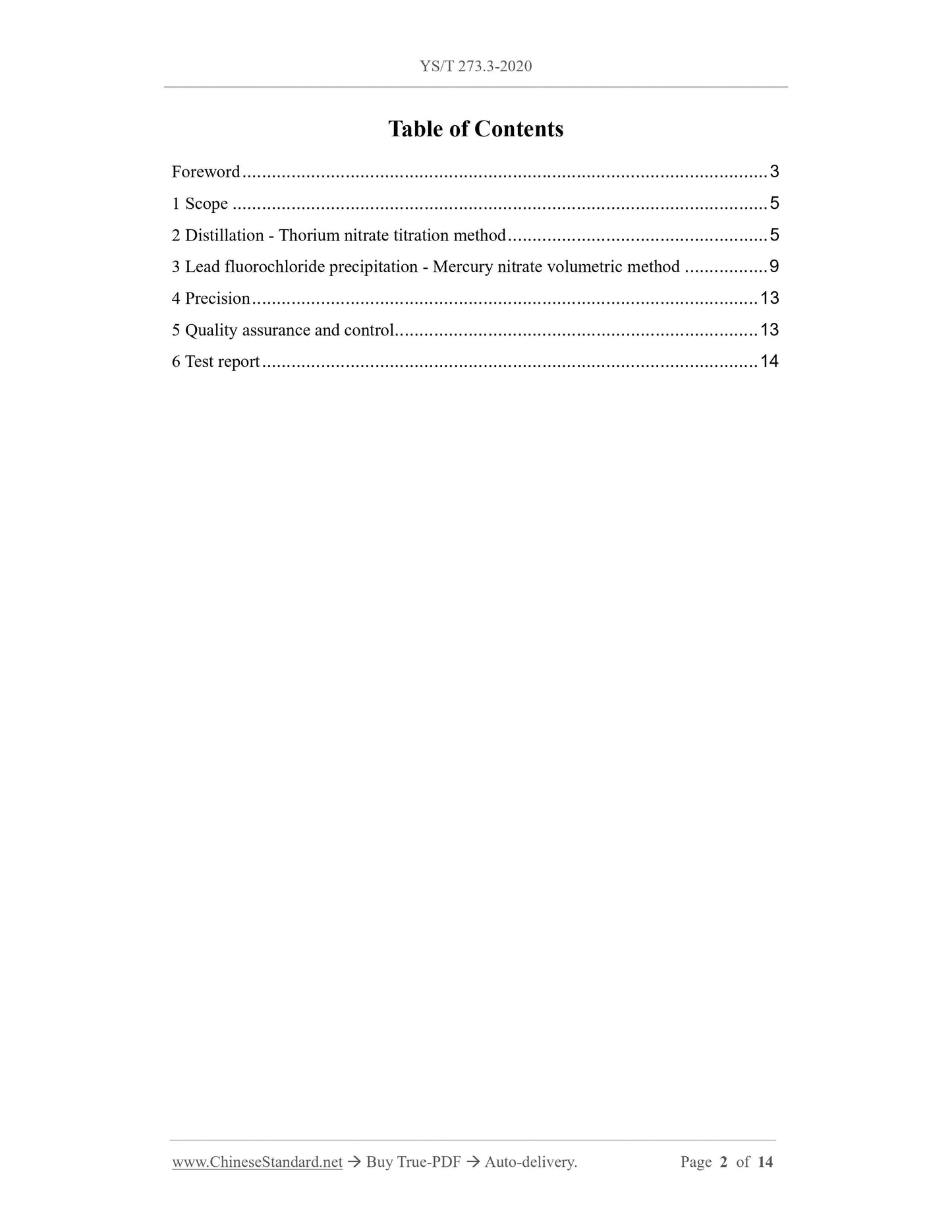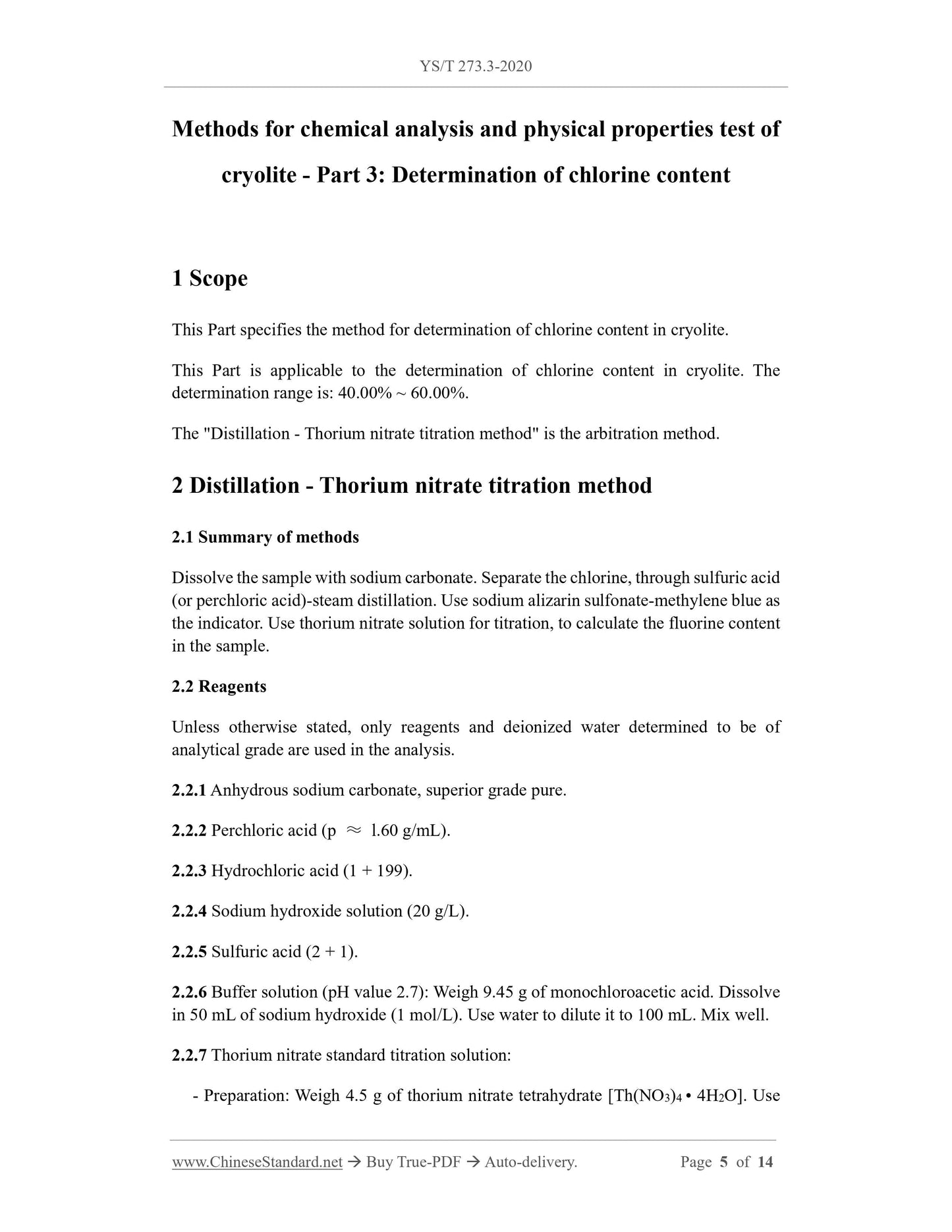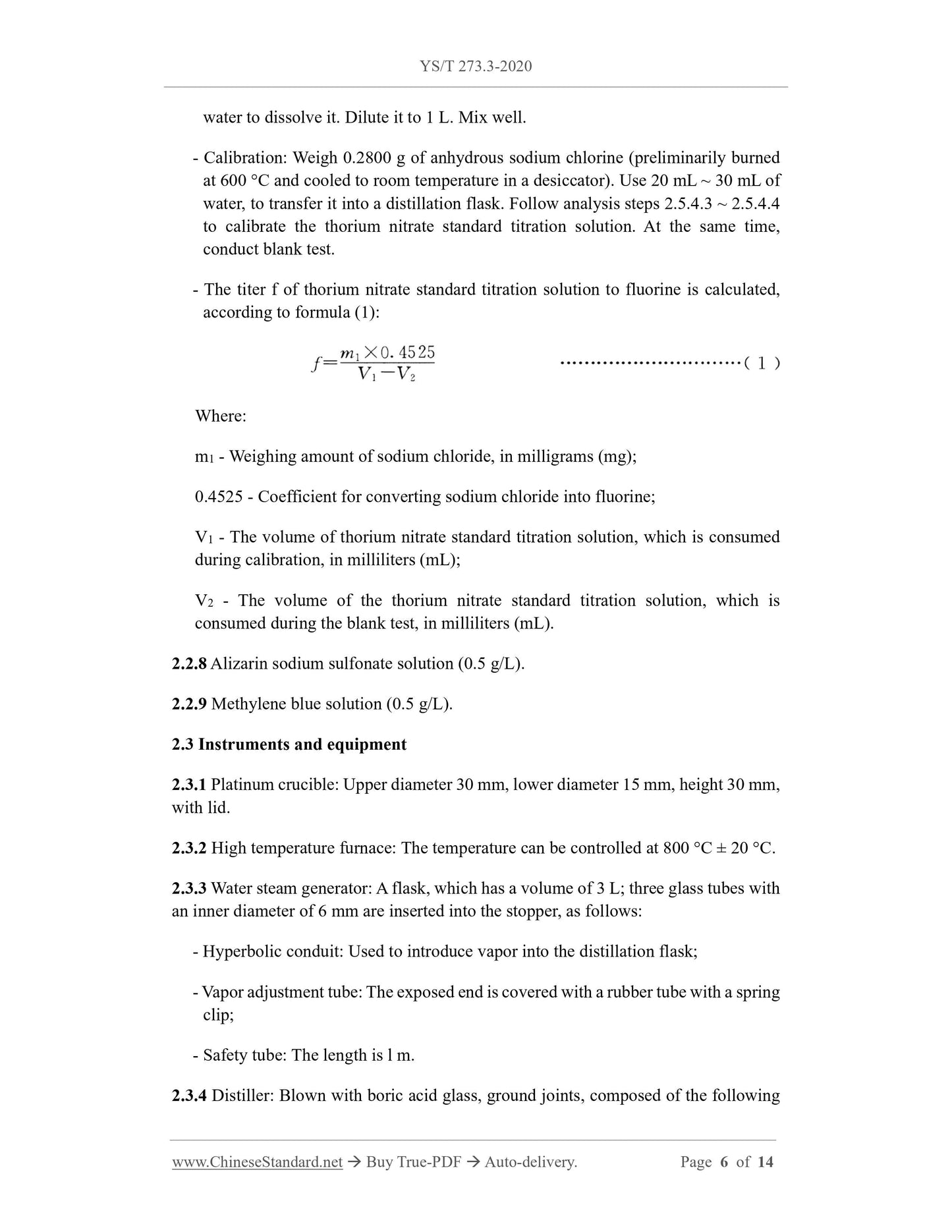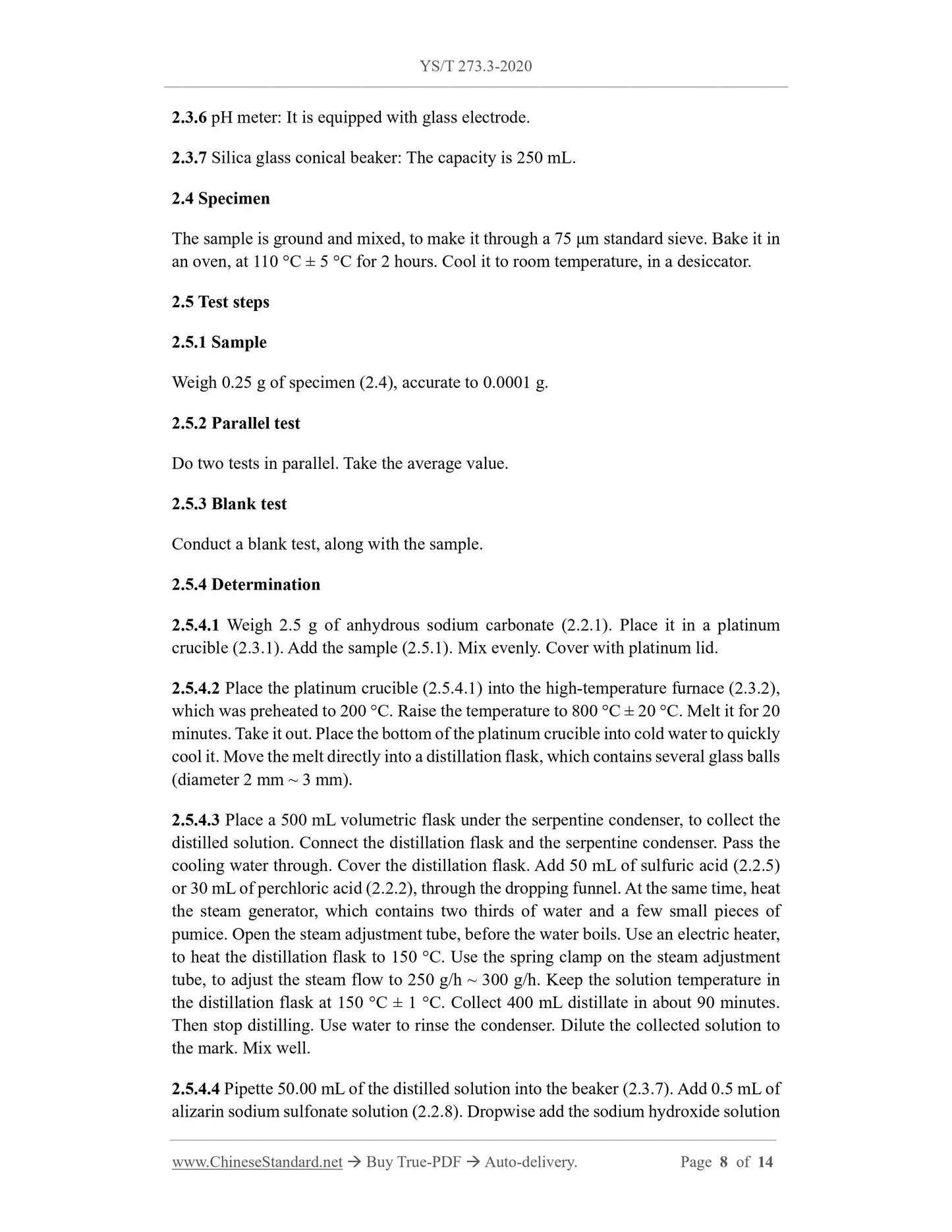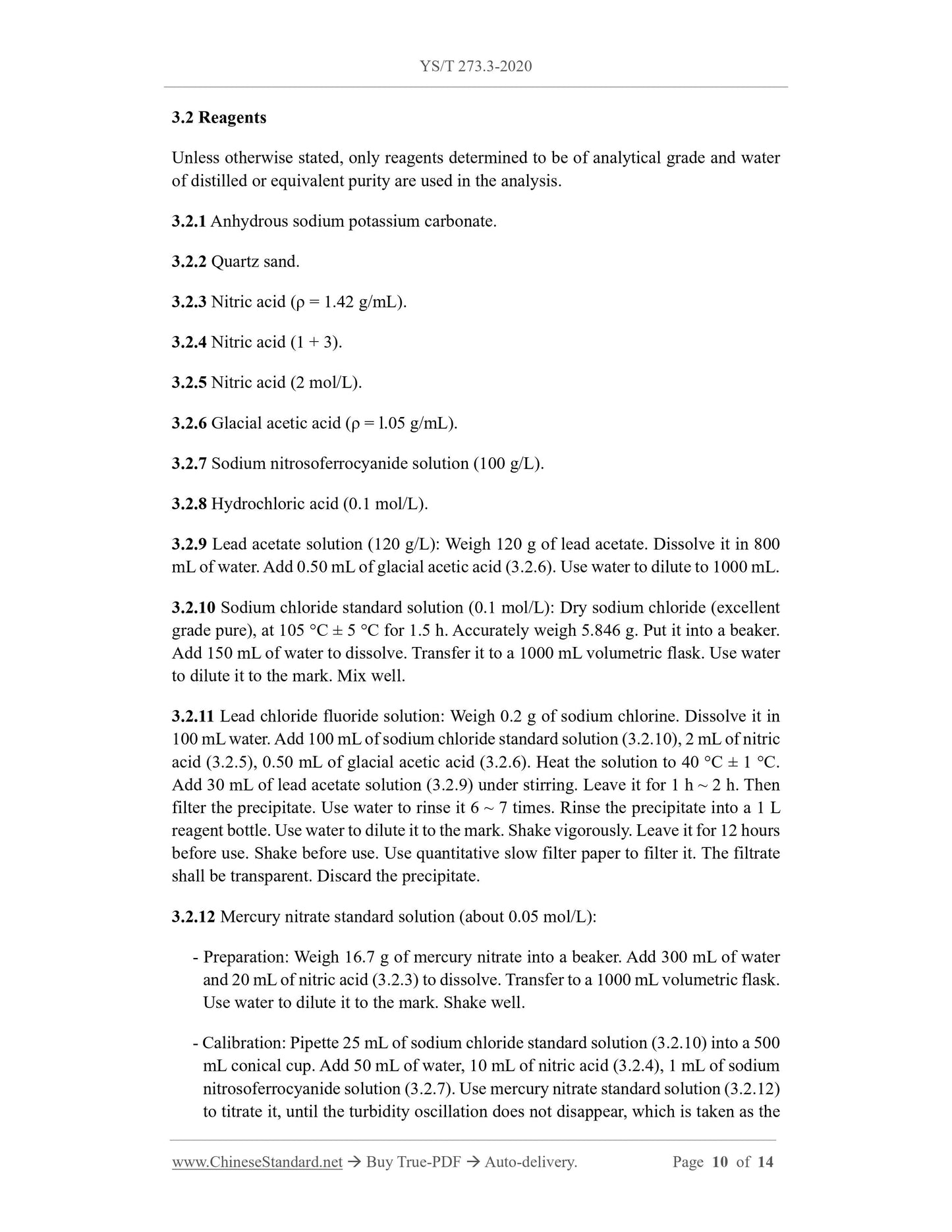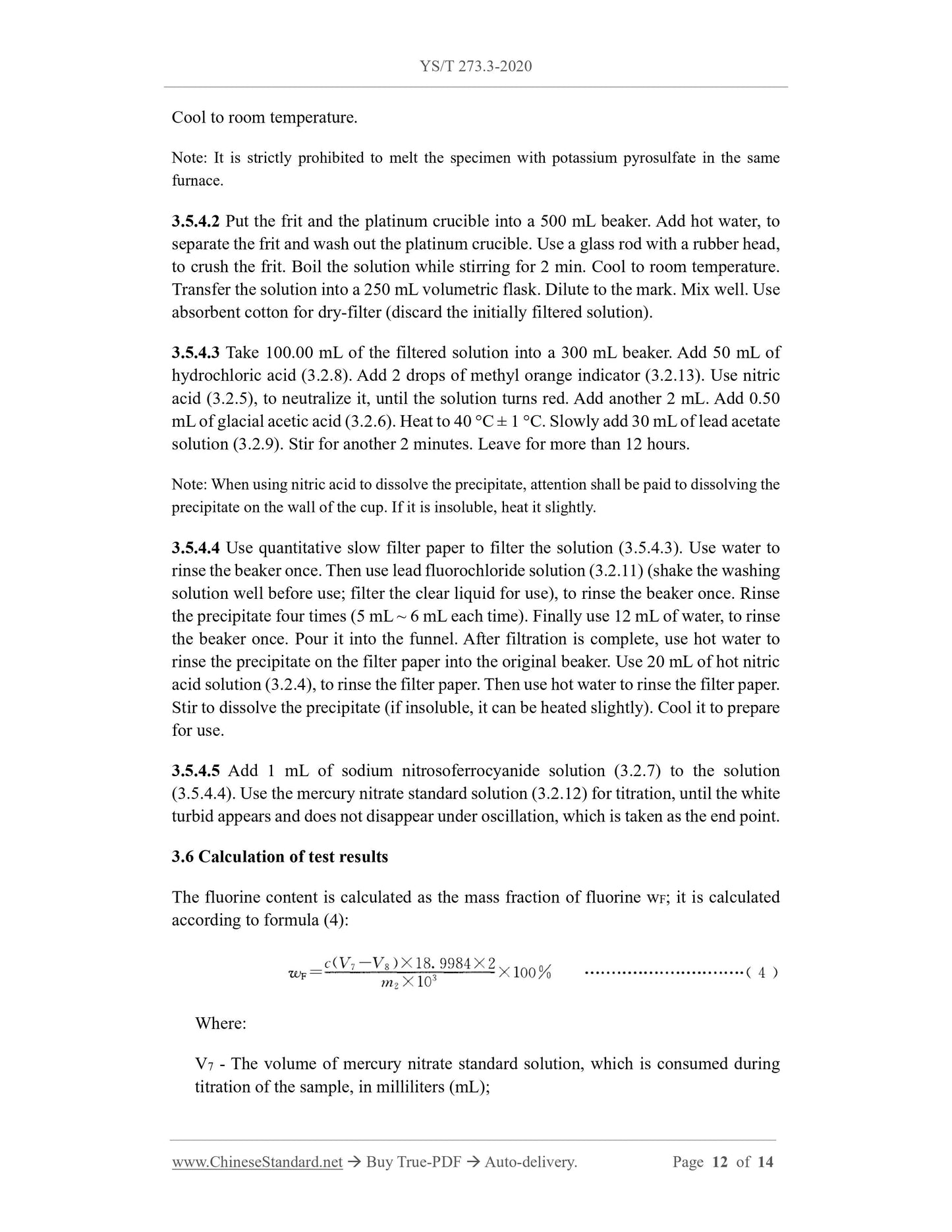1
/
of
7
PayPal, credit cards. Download editable-PDF and invoice in 1 second!
YS/T 273.3-2020 English PDF (YST273.3-2020)
YS/T 273.3-2020 English PDF (YST273.3-2020)
Regular price
$140.00 USD
Regular price
Sale price
$140.00 USD
Unit price
/
per
Shipping calculated at checkout.
Couldn't load pickup availability
Delivery: 3 seconds. Download true-PDF + Invoice.
Get QUOTATION in 1-minute: Click YS/T 273.3-2020
Historical versions: YS/T 273.3-2020
Preview True-PDF (Reload/Scroll if blank)
YS/T 273.3-2020: Chemical analysis methods and physical properties of cryolite - Part 3: Determination of fluoride content by distillation-thorium nitrate titration
YS/T 273.3-2020
YS
NONFERROUS METAL INDUSTRY STANDARD
OF THE PEOPLE’S REPUBLIC OF CHINA
ICS 71.100.10
H 30
Replacing YS/T 273.3-2012
Methods for chemical analysis and physical properties test of
cryolite - Part 3: Determination of chlorine content
ISSUED ON: DECEMBER 09, 2020
IMPLEMENTED ON: APRIL 01, 2021
Issued by: Ministry of Industry and Information Technology of PRC
Table of Contents
Foreword ... 3
1 Scope ... 5
2 Distillation - Thorium nitrate titration method ... 5
3 Lead fluorochloride precipitation - Mercury nitrate volumetric method ... 9
4 Precision ... 13
5 Quality assurance and control ... 13
6 Test report ... 14
Methods for chemical analysis and physical properties test of
cryolite - Part 3: Determination of chlorine content
1 Scope
This Part specifies the method for determination of chlorine content in cryolite.
This Part is applicable to the determination of chlorine content in cryolite. The
determination range is: 40.00% ~ 60.00%.
The "Distillation - Thorium nitrate titration method" is the arbitration method.
2 Distillation - Thorium nitrate titration method
2.1 Summary of methods
Dissolve the sample with sodium carbonate. Separate the chlorine, through sulfuric acid
(or perchloric acid)-steam distillation. Use sodium alizarin sulfonate-methylene blue as
the indicator. Use thorium nitrate solution for titration, to calculate the fluorine content
in the sample.
2.2 Reagents
Unless otherwise stated, only reagents and deionized water determined to be of
analytical grade are used in the analysis.
2.2.1 Anhydrous sodium carbonate, superior grade pure.
2.2.2 Perchloric acid (p ≈ l.60 g/mL).
2.2.3 Hydrochloric acid (1 + 199).
2.2.4 Sodium hydroxide solution (20 g/L).
2.2.5 Sulfuric acid (2 + 1).
2.2.6 Buffer solution (pH value 2.7): Weigh 9.45 g of monochloroacetic acid. Dissolve
in 50 mL of sodium hydroxide (1 mol/L). Use water to dilute it to 100 mL. Mix well.
2.2.7 Thorium nitrate standard titration solution:
- Preparation: Weigh 4.5 g of thorium nitrate tetrahydrate [Th(NO3)4 • 4H2O]. Use
water to dissolve it. Dilute it to 1 L. Mix well.
- Calibration: Weigh 0.2800 g of anhydrous sodium chlorine (preliminarily burned
at 600 °C and cooled to room temperature in a desiccator). Use 20 mL ~ 30 mL of
water, to transfer it into a distillation flask. Follow analysis steps 2.5.4.3 ~ 2.5.4.4
to calibrate the thorium nitrate standard titration solution. At the same time,
conduct blank test.
- The titer f of thorium nitrate standard titration solution to fluorine is calculated,
according to formula (1):
Where:
m1 - Weighing amount of sodium chloride, in milligrams (mg);
0.4525 - Coefficient for converting sodium chloride into fluorine;
V1 - The volume of thorium nitrate standard titration solution, which is consumed
during calibration, in milliliters (mL);
V2 - The volume of the thorium nitrate standard titration solution, which is
consumed during the blank test, in milliliters (mL).
2.2.8 Alizarin sodium sulfonate solution (0.5 g/L).
2.2.9 Methylene blue solution (0.5 g/L).
2.3 Instruments and equipment
2.3.1 Platinum crucible: Upper diameter 30 mm, lower diameter 15 mm, height 30 mm,
with lid.
2.3.2 High temperature furnace: The temperature can be controlled at 800 °C ± 20 °C.
2.3.3 Water steam generator: A flask, which has a volume of 3 L; three glass tubes with
an inner diameter of 6 mm are inserted into the stopper, as follows:
- Hyperbolic conduit: Used to introduce vapor into the distillation flask;
- Vapor adjustment tube: The exposed end is covered with a rubber tube with a spring
clip;
- Safety tube: The length is l m.
2.3.4 Distiller: Blown with boric acid glass, ground joints, composed of the following
2.3.6 pH meter: It is equipped with glass electrode.
2.3.7 Silica glass conical beaker: The capacity is 250 mL.
2.4 Specimen
The sample is ground and mixed, to make it through a 75 μm standard sieve. Bake it in
an oven, at 110 °C ± 5 °C for 2 hours. Cool it to room temperature, in a desiccator.
2.5 Test steps
2.5.1 Sample
Weigh 0.25 g of specimen (2.4), accurate to 0.0001 g.
2.5.2 Parallel test
Do two tests in parallel. Take the average value.
2.5.3 Blank test
Conduct a blank test, along with the sample.
2.5.4 Determination
2.5.4.1 Weigh 2.5 g of anhydrous sodium carbonate (2.2.1). Place it in a platinum
crucible (2.3.1). Add the sample (2.5.1). Mix evenly. Cover with platinum lid.
2.5.4.2 Place the platinum crucible (2.5.4.1) into the high-temperature furnace (2.3.2),
which was preheated to 200 °C. Raise the temperature to 800 °C ± 20 °C. Melt it for 20
minutes. Take it out. Place the bottom of the platinum crucible into cold water to quickly
cool it. Move the melt directly into a distillation flask, which contains several glass balls
(diameter 2 mm ~ 3 mm).
2.5.4.3 Place a 500 mL volumetric flask under the serpentine condenser, to collect the
distilled solution. Connect the distillation flask and the serpentine condenser. Pass the
cooling water through. Cover the distillation flask. Add 50 mL of sulfuric acid (2.2.5)
or 30 mL of perchloric acid (2.2.2), through the dropping funnel. At the same time, heat
the steam generator, which contains two thirds of water and a few small pieces of
pumice. Open the steam adjustment tube, before the water boils. Use an electric heater,
to heat the distillation flask to 150 °C. Use the spring clamp on the steam adjustment
tube, to adjust the steam flow to 250 g/h ~ 300 g/h. Keep the solution temperature in
the distillation flask at 150 °C ± 1 °C. Collect 400 mL distillate in about 90 minutes.
Then stop distilling. Use water to rinse the condenser. Dilute the collected solution to
the mark. Mix well.
2.5.4.4 Pipette 50.00 mL of the distilled solution into the beaker (2.3.7). Add 0.5 mL of
alizarin sodium sulfonate solution (2.2.8). Dropwise add the sodium hydroxide solution
3.2 Reagents
Unless otherwise stated, only reagents determined to be of analytical grade and water
of distilled or equivalent purity are used in the analysis.
3.2.1 Anhydrous sodium potassium carbonate.
3.2.2 Quartz sand.
3.2.3 Nitric acid (ρ = 1.42 g/mL).
3.2.4 Nitric acid (1 + 3).
3.2.5 Nitric acid (2 mol/L).
3.2.6 Glacial acetic acid (ρ = l.05 g/mL).
3.2.7 Sodium nitrosoferrocyanide solution (100 g/L).
3.2.8 Hydrochloric acid (0.1 mol/L).
3.2.9 Lead acetate solution (120 g/L): Weigh 120 g of lead acetate. Dissolve it in 800
mL of water. Add 0.50 mL of glacial acetic acid (3.2.6). Use water to dilute to 1000 mL.
3.2.10 Sodium chloride standard solution (0.1 mol/L): Dry sodium chloride (excellent
grade pure), at 105 °C ± 5 °C for 1.5 h. Accurately weigh 5.846 g. Put it into a beaker.
Add 150 mL of water to dissolve. Transfer it to a 1000 mL volumetric flask. Use water
to dilute it to the mark. Mix well.
3.2.11 Lead chloride fluoride solution: Weigh 0.2 g of sodium chlorine. Dissolve it in
100 mL water. Add 100 mL of sodium chloride standard solution (3.2.10), 2 mL of nitric
acid (3.2.5), 0.50 mL of glacial acetic acid (3.2.6). Heat the solution to 40 °C ± 1 °C.
Add 30 mL of lead acetate solution (3.2.9) under stirring. Leave it for 1 h ~ 2 h. Then
filter the precipitate. Use water to rinse it 6 ~ 7 times. Rinse the precipitate into a 1 L
reagent bottle. Use water to dilute it to the mark. Shake vigorously. Leave it for 12 hours
before use. Shake before use. Use quantitative slow filter paper to f...
Get QUOTATION in 1-minute: Click YS/T 273.3-2020
Historical versions: YS/T 273.3-2020
Preview True-PDF (Reload/Scroll if blank)
YS/T 273.3-2020: Chemical analysis methods and physical properties of cryolite - Part 3: Determination of fluoride content by distillation-thorium nitrate titration
YS/T 273.3-2020
YS
NONFERROUS METAL INDUSTRY STANDARD
OF THE PEOPLE’S REPUBLIC OF CHINA
ICS 71.100.10
H 30
Replacing YS/T 273.3-2012
Methods for chemical analysis and physical properties test of
cryolite - Part 3: Determination of chlorine content
ISSUED ON: DECEMBER 09, 2020
IMPLEMENTED ON: APRIL 01, 2021
Issued by: Ministry of Industry and Information Technology of PRC
Table of Contents
Foreword ... 3
1 Scope ... 5
2 Distillation - Thorium nitrate titration method ... 5
3 Lead fluorochloride precipitation - Mercury nitrate volumetric method ... 9
4 Precision ... 13
5 Quality assurance and control ... 13
6 Test report ... 14
Methods for chemical analysis and physical properties test of
cryolite - Part 3: Determination of chlorine content
1 Scope
This Part specifies the method for determination of chlorine content in cryolite.
This Part is applicable to the determination of chlorine content in cryolite. The
determination range is: 40.00% ~ 60.00%.
The "Distillation - Thorium nitrate titration method" is the arbitration method.
2 Distillation - Thorium nitrate titration method
2.1 Summary of methods
Dissolve the sample with sodium carbonate. Separate the chlorine, through sulfuric acid
(or perchloric acid)-steam distillation. Use sodium alizarin sulfonate-methylene blue as
the indicator. Use thorium nitrate solution for titration, to calculate the fluorine content
in the sample.
2.2 Reagents
Unless otherwise stated, only reagents and deionized water determined to be of
analytical grade are used in the analysis.
2.2.1 Anhydrous sodium carbonate, superior grade pure.
2.2.2 Perchloric acid (p ≈ l.60 g/mL).
2.2.3 Hydrochloric acid (1 + 199).
2.2.4 Sodium hydroxide solution (20 g/L).
2.2.5 Sulfuric acid (2 + 1).
2.2.6 Buffer solution (pH value 2.7): Weigh 9.45 g of monochloroacetic acid. Dissolve
in 50 mL of sodium hydroxide (1 mol/L). Use water to dilute it to 100 mL. Mix well.
2.2.7 Thorium nitrate standard titration solution:
- Preparation: Weigh 4.5 g of thorium nitrate tetrahydrate [Th(NO3)4 • 4H2O]. Use
water to dissolve it. Dilute it to 1 L. Mix well.
- Calibration: Weigh 0.2800 g of anhydrous sodium chlorine (preliminarily burned
at 600 °C and cooled to room temperature in a desiccator). Use 20 mL ~ 30 mL of
water, to transfer it into a distillation flask. Follow analysis steps 2.5.4.3 ~ 2.5.4.4
to calibrate the thorium nitrate standard titration solution. At the same time,
conduct blank test.
- The titer f of thorium nitrate standard titration solution to fluorine is calculated,
according to formula (1):
Where:
m1 - Weighing amount of sodium chloride, in milligrams (mg);
0.4525 - Coefficient for converting sodium chloride into fluorine;
V1 - The volume of thorium nitrate standard titration solution, which is consumed
during calibration, in milliliters (mL);
V2 - The volume of the thorium nitrate standard titration solution, which is
consumed during the blank test, in milliliters (mL).
2.2.8 Alizarin sodium sulfonate solution (0.5 g/L).
2.2.9 Methylene blue solution (0.5 g/L).
2.3 Instruments and equipment
2.3.1 Platinum crucible: Upper diameter 30 mm, lower diameter 15 mm, height 30 mm,
with lid.
2.3.2 High temperature furnace: The temperature can be controlled at 800 °C ± 20 °C.
2.3.3 Water steam generator: A flask, which has a volume of 3 L; three glass tubes with
an inner diameter of 6 mm are inserted into the stopper, as follows:
- Hyperbolic conduit: Used to introduce vapor into the distillation flask;
- Vapor adjustment tube: The exposed end is covered with a rubber tube with a spring
clip;
- Safety tube: The length is l m.
2.3.4 Distiller: Blown with boric acid glass, ground joints, composed of the following
2.3.6 pH meter: It is equipped with glass electrode.
2.3.7 Silica glass conical beaker: The capacity is 250 mL.
2.4 Specimen
The sample is ground and mixed, to make it through a 75 μm standard sieve. Bake it in
an oven, at 110 °C ± 5 °C for 2 hours. Cool it to room temperature, in a desiccator.
2.5 Test steps
2.5.1 Sample
Weigh 0.25 g of specimen (2.4), accurate to 0.0001 g.
2.5.2 Parallel test
Do two tests in parallel. Take the average value.
2.5.3 Blank test
Conduct a blank test, along with the sample.
2.5.4 Determination
2.5.4.1 Weigh 2.5 g of anhydrous sodium carbonate (2.2.1). Place it in a platinum
crucible (2.3.1). Add the sample (2.5.1). Mix evenly. Cover with platinum lid.
2.5.4.2 Place the platinum crucible (2.5.4.1) into the high-temperature furnace (2.3.2),
which was preheated to 200 °C. Raise the temperature to 800 °C ± 20 °C. Melt it for 20
minutes. Take it out. Place the bottom of the platinum crucible into cold water to quickly
cool it. Move the melt directly into a distillation flask, which contains several glass balls
(diameter 2 mm ~ 3 mm).
2.5.4.3 Place a 500 mL volumetric flask under the serpentine condenser, to collect the
distilled solution. Connect the distillation flask and the serpentine condenser. Pass the
cooling water through. Cover the distillation flask. Add 50 mL of sulfuric acid (2.2.5)
or 30 mL of perchloric acid (2.2.2), through the dropping funnel. At the same time, heat
the steam generator, which contains two thirds of water and a few small pieces of
pumice. Open the steam adjustment tube, before the water boils. Use an electric heater,
to heat the distillation flask to 150 °C. Use the spring clamp on the steam adjustment
tube, to adjust the steam flow to 250 g/h ~ 300 g/h. Keep the solution temperature in
the distillation flask at 150 °C ± 1 °C. Collect 400 mL distillate in about 90 minutes.
Then stop distilling. Use water to rinse the condenser. Dilute the collected solution to
the mark. Mix well.
2.5.4.4 Pipette 50.00 mL of the distilled solution into the beaker (2.3.7). Add 0.5 mL of
alizarin sodium sulfonate solution (2.2.8). Dropwise add the sodium hydroxide solution
3.2 Reagents
Unless otherwise stated, only reagents determined to be of analytical grade and water
of distilled or equivalent purity are used in the analysis.
3.2.1 Anhydrous sodium potassium carbonate.
3.2.2 Quartz sand.
3.2.3 Nitric acid (ρ = 1.42 g/mL).
3.2.4 Nitric acid (1 + 3).
3.2.5 Nitric acid (2 mol/L).
3.2.6 Glacial acetic acid (ρ = l.05 g/mL).
3.2.7 Sodium nitrosoferrocyanide solution (100 g/L).
3.2.8 Hydrochloric acid (0.1 mol/L).
3.2.9 Lead acetate solution (120 g/L): Weigh 120 g of lead acetate. Dissolve it in 800
mL of water. Add 0.50 mL of glacial acetic acid (3.2.6). Use water to dilute to 1000 mL.
3.2.10 Sodium chloride standard solution (0.1 mol/L): Dry sodium chloride (excellent
grade pure), at 105 °C ± 5 °C for 1.5 h. Accurately weigh 5.846 g. Put it into a beaker.
Add 150 mL of water to dissolve. Transfer it to a 1000 mL volumetric flask. Use water
to dilute it to the mark. Mix well.
3.2.11 Lead chloride fluoride solution: Weigh 0.2 g of sodium chlorine. Dissolve it in
100 mL water. Add 100 mL of sodium chloride standard solution (3.2.10), 2 mL of nitric
acid (3.2.5), 0.50 mL of glacial acetic acid (3.2.6). Heat the solution to 40 °C ± 1 °C.
Add 30 mL of lead acetate solution (3.2.9) under stirring. Leave it for 1 h ~ 2 h. Then
filter the precipitate. Use water to rinse it 6 ~ 7 times. Rinse the precipitate into a 1 L
reagent bottle. Use water to dilute it to the mark. Shake vigorously. Leave it for 12 hours
before use. Shake before use. Use quantitative slow filter paper to f...
Share
